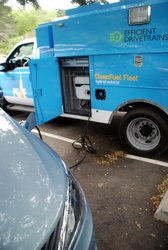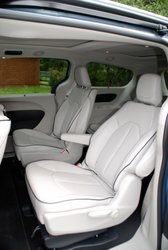Buy It Because It’s a Great Minivan; Love It Because It Plugs In
Chrysler invented the minivan back in the Eighties and it’s been a mainstay in the market until recently, when car-based crossovers added a third row of seating, bumped up their styling and fuel economy. The one-box design of the minivan has always been the height of functionality, but that was pretty much all it had to offer. The 2017 Chrysler Pacifica Hybrid is the serious challenge to the new status quo—a strong attempt by Chrysler to retake the high ground with a new approach to the category.

At the Western Automotive Journalists 2017 Media Day program, we had our first opportunity to spend some time in the plug-in hybrid Pacifica. We came away quite impressed. Chrysler’s long history with the minivan shows. The result is a vehicle that we predict will become the new benchmark for the segment.
The heart of the Pacifica Hybrid is a plug-in hybrid powertrain designed to deliver unheard fuel economy for a big people hauler. The gasoline 3.6-liter V6 is pretty standard minivan fare, but in this case it routes power through an eFlite SI-EVT transmission (which includes two electric drive motors) and is paired with a 16 kWh lithium-ion battery. With that you get 33 miles of pure electric driving on a full charge. It defaults back to 32 mpg combined when just running in hybrid mode, light years ahead of its minivan competition. The MPGe (miles per gallon equivalent, which factors in the energy efficiency of the electricity coming from the battery) for the Pacifica is an even more impressive 84. With its combined electric and gas power the Pacifica should deliver more than 550 miles of range.
The hybrid powertrain is slick and clearly delivers some great fuel economy, but the smartest thing Chrysler has done is wrap it up in one of the best redesigns the minivan category has seen. Touches of luxury abound in the 2017 Chrysler Pacifica Hybrid Platinum trim level (the entry-level Hybrid is the Premium, which means there are no bargain-basement versions. The Hybrid versions of the Pacifica start at $41,995 (plus a $1,095 destination charge), a $13,400 bump over the base non-Hybrid Pacifica. But if if you look through the option list, which includes an almost endless batch of technology and functional add-ons, it looks like the up-charge for the hybrid is closer to a couple thousand dollars. Our top-of-the-line test model topped out at $47,885 (including the destination charge), but it appeared to have every available option.

One of the first things you’ll notice in the Pacifica Hybrid is counter-intuitive. In electric mode, you’ll hear more noise than you might expect. It’s not coming from the engine, but you’ll hear road noise that would normally be masked by the engine. It’s not loud enough to be annoying (Chrysler uses noise-cancelling technology to quiet the expansive interior of the minivan, but it’s unique to this model.
Steering is brisk in the 2017 Chrysler Pacifica Hybrid. It’s much more nimble than its girth might indicate. The four-wheel disc brakes with regenerative braking to feed energy into the battery work seamlessly; the regen is mild compared to some systems on the market.

The minivan’s safety technology, a Chrysler hallmark since it became the first company to add airbags throughout its lineup, includes some great modern equipment. Airbags cover all of the seven seating positions. The Pacifica features a 360-degree view camera, optional forward collision warning with active braking, optional parallel and perpendicular parking assistance, adaptive cruise control and rear cross path detection.
We look forward to being about to spend a week in the 2017 Pacifica Hybrid to check it out in a more extended drive, but this first spin definitely puts this family wagon squarely in the battle for the hearts and minds of those who have people and things to move and want to do it with maximum efficiency.
As a footnote we should acknowledge that this is not the first time Chrysler has added a plug to its minivan. Back in the 1990s it did a short run of all-electric versions of its minivan at the time labeled the TEVan. Less than 100 were produced and it disappeared pretty quickly, though Chrysler made another run with the next generation minivan (this one labeled the EPIC (for Electric Powered Interurban Commuter), but also abandoned it after a couple years. Both were offered for lease-only because of the early stage of the battery technology.
Related Stories You Might Enjoy
Road Test: 2014 Honda Odyssey
Road Test: 2016 Volvo XC90 PHEV
Road Test: 2016 BMW X5 xDrive40e
Disclosure:
Clean Fleet Report is loaned free test vehicles from automakers to evaluate, typically for a week at a time. Our road tests are based on this one-week drive of a new vehicle. Because of this we don’t address issues such as long-term reliability or total cost of ownership. In addition we are often invited to manufacturer events highlighting new vehicles or technology. As part of these events we may be offered free transportation, lodging or meals. We do our best to present our unvarnished evaluations of vehicles and news irrespective of these inducements.
Our focus is on vehicles that offer the best fuel economy in their class. We also feature those that are among the top mpg vehicles in their class. In addition, we aim to offer reviews and news on advanced technology and the alternative fuel vehicle market. We welcome any feedback from vehicle owners and are dedicated to providing a forum for alternative viewpoints. Please let us know your views at publisher@cleanfleetreport.com.

5 thoughts on “First Drive: 2017 Chrysler Pacifica Hybrid”